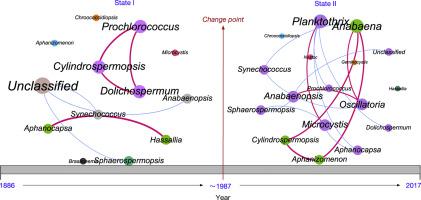Water Research ( IF 12.8 ) Pub Date : 2020-06-23 , DOI: 10.1016/j.watres.2020.116077 Xiaofeng Cao 1 , Xiaoyan Xu 2 , Rui Bian 3 , Yajun Wang 1 , Hongwei Yu 1 , Yan Xu 1 , Gaoqi Duan 1 , Lijiao Bi 1 , Pengfei Chen 4 , Shaopeng Gao 5 , Jie Wang 6 , Jianfeng Peng 1 , Jiuhui Qu 1

|
Harmful cyanobacterial blooms consisting of toxic taxa can produce a wide variety of toxins to threaten water quality, ecosystem functions and services. Of greater concern was the changing patterns of cyanobacterial assemblage were not well understood due to the lack of long-term monitoring data over the temporal scale. Biodiversity change in cyanobacterial community and paleoenvironmental variables over the past 170 years in Lake Chenghai were investigated based on sedimentary ancient DNA metabarcoding and traditional paleolimnological analysis. The results showed species richness and homogenization of cyanobacterial assemblage increased in the most recent decades, which were synchronized with the growth of artificial fertilization and decline in precipitation. Cyanobacterial co-occurrence network analysis revealed more complex interactions and weak community stability after the change point of ∼1987, while the rare cyanobacterial genera such as Anabaena, Planktothrix, Oscillatoria and Microcystis were identified to be keystone taxa affecting cyanobacterial assemblage. Furthermore, an increase of toxin-producing cyanobacterial taxa was significantly and positively associated with TN and TP, as well as TN/IP and TN/TP, which was verified by quantitative real-time PCR of mcyA and rpoC1 genes. Threshold in total nitrogen (TN) concentration should be targeted no more than 0.60 mg/L to alleviate nuisance cyanobacterial blooms in Lake Chenghai. These findings reinforce the comprehensive understanding for the long-term dynamics of cyanobacterial assemblage responding to environmental change, which could contribute to proactively regulate environmental conditions for avoiding undesirable ecological consequences.
中文翻译:

沉积的古代DNA元条形码描述了湖蓝藻群落的相对时间变化。
由有毒的类群组成的有害蓝藻绽放会产生多种毒素,威胁到水质,生态系统功能和服务。更令人担忧的是,由于缺乏在时间尺度上的长期监测数据,对蓝细菌装配的变化模式还没有很好的理解。基于沉积古DNA元条形码和传统古湖泊学分析,研究了澄海湖170年来蓝细菌群落的生物多样性变化和古环境变量。结果表明,在最近的几十年中,蓝细菌群落的物种丰富度和均质性有所增加,这与人工受精的增长和降水的减少同步。鱼腥藻,浮游生物,颤藻和微囊藻被确定为是影响蓝藻菌群的关键类群。此外,产生毒素的蓝细菌类群的增加与TN和TP以及TN / IP和TN / TP显着正相关,这已通过mcyA和rpoC1的实时定量PCR验证。基因。总氮(TN)浓度的阈值不得超过0.60 mg / L,以减轻澄海湖中有害的蓝藻水华。这些发现加强了对蓝细菌集合体响应环境变化的长期动态的全面理解,这可以有助于主动调节环境条件,从而避免不良的生态后果。


























 京公网安备 11010802027423号
京公网安备 11010802027423号